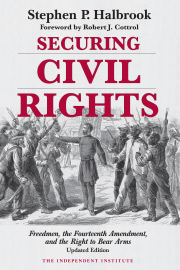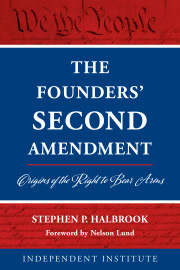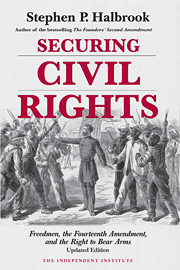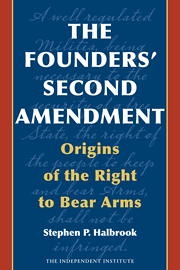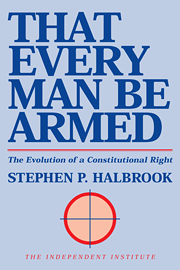State and federal agencies routinely issue “guidance” in the form of public statements and private letters that are actually veiled commands and threats of adverse consequences for failure to obey. Interpretive regulations, which supposedly only express an agency’s opinion and are non-binding, may serve the same function. Such communications may be beyond the agency’s legal authority or may be a way to circumvent required notice and comment procedures for formal legislative regulations. This type of coercion may violate rights under the Second Amendment and other constitutional rights, not to mention required administrative procedures.
This post assesses two cases pending in the Supreme Court in which agency guidance is being used to threaten Second Amendment rights. National Rifle Ass’n v. Vullo concerns how New York officials threatened commercial entities not to do business with the NRA in an effort to suppress Second Amendment advocacy. Garland v. Cargill involves the extent to which the executive branch may expand gun crimes beyond what Congress has enacted through supposedly non-mandatory interpretive regulations.
In addition, because agencies often insist that courts defer to their legal and factual conclusions, it is relevant to discuss the pending Loper and Relentless cases in which the Supreme Court will decide whether to tank the Chevron deference rule.
The issue presented in NRA v. Vullo is: “Does the First Amendment permit a government official to threaten regulated entities with adverse regulatory action if they do business with an advocacy organization, where she does so because she disapproves of its political views or because those views are unpopular?” NRA is represented by two First Amendment super-lawyers—David Cole of the ACLU Foundation and the Conspiracy’s own Eugene Volokh.
Since the Second Circuit upheld dismissal of the complaint for failure to state a claim on which relief may be granted, the NRA’s allegations must be taken as true. As recounted in NRA’s brief, Maria Vullo, Superintendent of the New York State Department of Financial Services, wrote “guidance letters” to the heads of banks and insurance companies that it regulates. She urged them to cut ties with the NRA based on their legal obligation to consider “reputational risk.” A failure to consider such risk can lead to multi-million-dollar fines.
The letters cited the NRA’s “gun promotion” advocacy, not any legal infraction. In meetings with insurance executives, Vullo threatened enforcement action for alleged unrelated violations unless they discontinued doing business with the NRA. Vullo also issued a press release urging insurance companies and banks not to do business with the NRA.
Based on such “guidance,” Vullo then strong-armed Lloyd’s and two other insurers to sign consent orders requiring the payment of multimillion-dollar fines and requiring them to forego any insurance programs with the NRA.
Itself a prolific issuer of guidance documents, the United States filed an amicus curiae brief in support of neither party. The brief concedes that NRA stated a plausible claim that Vullo violated the First Amendment by coercing regulated entities to terminate their business with NRA in an effort to suppress NRA’s advocacy.
But according to the amicus brief, the first four paragraphs of Vullo’s letter presented no First Amendment issue, and instead simply attempted “to convince, not coerce, private parties to cut ties with [NRA] because of [NRA’s] firearms advocacy.” The letter decried recent shootings and noted the backlash against the NRA, which “promote[s] guns that lead to senseless violence.” Attacking the NRA for its pro-gun “speech” supposedly did not threaten the letter recipients with sanctions.
It did not matter, the brief of the United States continues, that the letters were issued to regulated entities pursuant to the statutory authority of the Department of Financial Services to provide “guidance.” Agencies need not “limit their public advocacy to discouraging illegal conduct or addressing subjects within the scope of their regulatory authority,” but may condemn practices that they have no statutory or constitutional authority to regulate.
This is an extremely naïve view of reality. A weaponized agency tells its regulated subjects that the NRA and guns are bad and urges them to cut ties. This was not a political speech given by the governor to the general public that did not threaten sanctions. On the contrary, then-Governor Cuomo confirmed the threats by tweeting that “the NRA is an extremist organization,” that businesses risked “‘reputational risks’ with any association with the NRA,” and that New York was “forcing the NRA into financial jeopardy.”
Turning to “guidance” documents at the federal level, the Bureau of Alcohol, Tobacco, Firearms & Explosives (ATF) has long history of issuing what I’ll call “advisories” that had better be followed unless you want to risk license revocation or criminal charges. These include private letters, classifications of firearms directed to manufacturers and importers, open letters to the public, the FFL Newsletter, and formal ATF Rulings. None of these documents have the force of law, but can be ignored only at your peril absent a judicial ruling to the contrary.
Because of this coercive practice, Jeff Sessions, the first Attorney General appointed by President Trump, issued a Prohibition on Improper Guidance Documents (2017). Two of its provisions stated:
- Guidance documents should identify themselves as guidance, disclaim any force or effect of law, and avoid language suggesting that the public has obligations that go beyond those set forth in the applicable statutes or legislative rules.
- Guidance documents should not be used for the purpose of coercing persons or entities outside the federal government into taking any action or refraining from taking any action beyond what is required by the terms of the applicable statute or regulation.
That was followed by Executive Order 13891 (2019), which formalized the above policies. President Biden revoked that order the day he took office on January 20, 2021.
Meanwhile, ATF promulgated a regulation of a type it had never issued before—expanding the definition of a “firearm” in the National Firearms Act (NFA) beyond the definitions enacted by Congress. It defined bump stocks as “machineguns,” which it previously opined were not machineguns. Litigants were immediately off to the races.
In Guedes v. ATF, the D.C. Circuit affirmed the denial of a preliminary injunction against enforcement of the new rule. Strangely, ATF took the litigating position that it had promulgated an interpretive rule which was not entitled to Chevron deference, not a legislative rule, to which Chevron deference applied. The court found that the rule on its face was legislative, explicitly informing bump-stock owners that their devices “will be prohibited when this rule becomes effective.”
When the government tells you that something is illegal—whether it’s in a “guidance” letter, an informal ruling, or an interpretive rule—you’d better comply or lawyer-up.
The D.C. Circuit accorded deference to the rule, even though the NFA is a criminal statute which does not delegate power to ATF to expand. It found the definition of “machinegun” to be ambiguous but rejected application of the rule of lenity, which the Supreme Court applied to NFA definitions in U.S. v. Thompson/Center Arms (and which yours truly argued). But as will be seen, the rule of lenity remains alive and well.
In Garland v. Cargill, the Fifth Circuit en banc found that, on the merits, bump stocks are not machineguns, with some judges seeing the statute as sufficiently ambiguous to apply the rule of lenity. Not surprisingly, the Supreme Court granted certiorari.
In its brief, the United States tells the Supreme Court that “this case presents a pure question of statutory interpretation: Whether bump stocks satisfy the definition of ‘machinegun’....” Now for the shocker: “ATF has set forth its position on that question in an interpretive rule, but the government does not contend that the rule has the force and effect of law or that ATF’s interpretation is entitled to deference.”
I’ve litigated cases adversely to ATF for decades, and don’t recall any in which ATF didn’t argue that it was entitled to “the divine right of deference” (the modern version of “the divine right of kings”). The brief here has the names of my old adversaries who made that argument countless times, Mark Stern and Michael Raab. Like Captain Renault in Casablanca, I’m shocked, shocked to find that ATF is not arguing for deference. But there are perhaps two reasons why.
First, as the government’s brief says, “neither ATF’s changes in position nor any asserted defects in its explanation for those changes have any bearing on the Court’s resolution of the question presented.” If deference is the rule, deference to which ATF opinion? The consistent opinion that lasted for years before the new rule, or the latest one invented for the rule?
Second, does Garland see the possible handwriting on the wall regarding the Chevron deference rule? That brings us to Loper Bright Enterprises v. Raimondo and Relentless v. Dep’t of Commerce, which were argued on January 17. An agency rule requires the herring industry to bear the costs of federal observers on fishing boats. The issue: “Whether the court should overrule Chevron v. Natural Resources Defense Council, or at least clarify that statutory silence concerning controversial powers expressly but narrowly granted elsewhere in the statute does not constitute an ambiguity requiring deference to the agency.”
If the answer to that question is affirmative, that may condemn ATF’s latest regulations on frames or receivers, pistol braces, and what it means to engage in the business of dealing in firearms. Congress was very specific in defining the statutory regime on these matters, and delegated no regulatory power for ATF to push the envelope.
The oral arguments are well worth listening to—Paul Clement argued for Loper, Roman Martinez argued for Relentless, and Solicitor General Elizabeth Prelogar argued both cases for the United States in what seemed to be a sinking ship.
As expected, Justices Gorsuch and Kavanaugh pressed hard against Chevron, which was stoutly defended by the three liberal justices. The Chief Justice and Justice Thomas asked the intriguing question of whether the courts must defer to agencies regarding constitutional issues, such as whether an activity constitutes interstate commerce. General Prelogar backed away from defending that radical extension of the doctrine.
The resolution of the above cases will affect the extent to which state and federal agencies infringe Second Amendment rights by use of implied and actual diktats. As usual, keep your fingers crossed.




